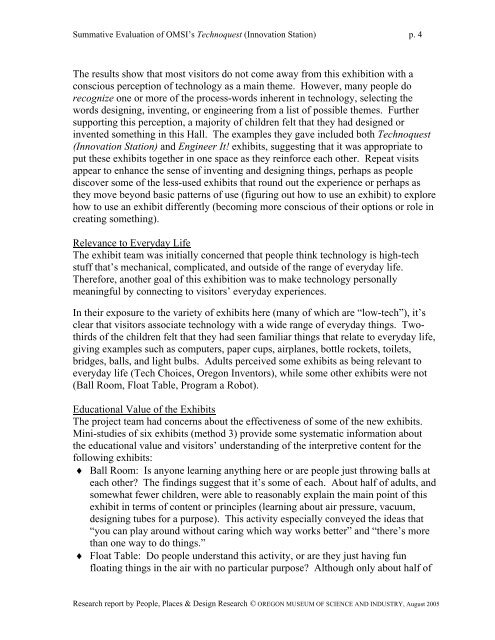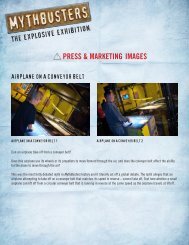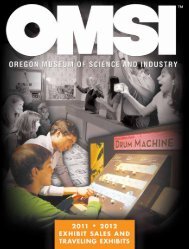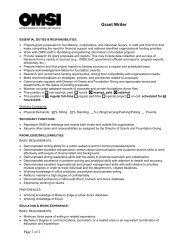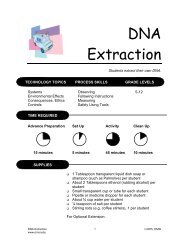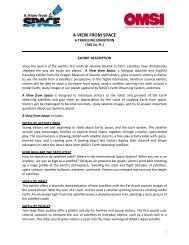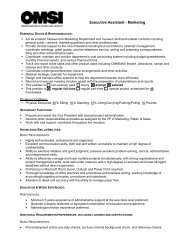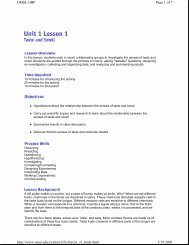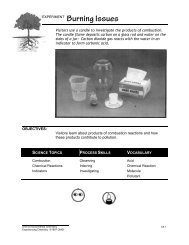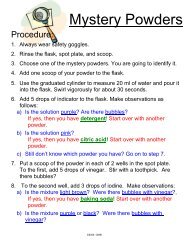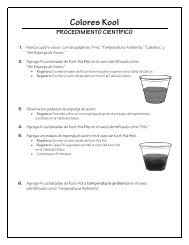Summative Evaluation - OMSI
Summative Evaluation - OMSI
Summative Evaluation - OMSI
Create successful ePaper yourself
Turn your PDF publications into a flip-book with our unique Google optimized e-Paper software.
<strong>Summative</strong> <strong>Evaluation</strong> of <strong>OMSI</strong>’s Technoquest (Innovation Station) p. 4The results show that most visitors do not come away from this exhibition with aconscious perception of technology as a main theme. However, many people dorecognize one or more of the process-words inherent in technology, selecting thewords designing, inventing, or engineering from a list of possible themes. Furthersupporting this perception, a majority of children felt that they had designed orinvented something in this Hall. The examples they gave included both Technoquest(Innovation Station) and Engineer It! exhibits, suggesting that it was appropriate toput these exhibits together in one space as they reinforce each other. Repeat visitsappear to enhance the sense of inventing and designing things, perhaps as peoplediscover some of the less-used exhibits that round out the experience or perhaps asthey move beyond basic patterns of use (figuring out how to use an exhibit) to explorehow to use an exhibit differently (becoming more conscious of their options or role increating something).Relevance to Everyday LifeThe exhibit team was initially concerned that people think technology is high-techstuff that’s mechanical, complicated, and outside of the range of everyday life.Therefore, another goal of this exhibition was to make technology personallymeaningful by connecting to visitors’ everyday experiences.In their exposure to the variety of exhibits here (many of which are “low-tech”), it’sclear that visitors associate technology with a wide range of everyday things. Twothirdsof the children felt that they had seen familiar things that relate to everyday life,giving examples such as computers, paper cups, airplanes, bottle rockets, toilets,bridges, balls, and light bulbs. Adults perceived some exhibits as being relevant toeveryday life (Tech Choices, Oregon Inventors), while some other exhibits were not(Ball Room, Float Table, Program a Robot).Educational Value of the ExhibitsThe project team had concerns about the effectiveness of some of the new exhibits.Mini-studies of six exhibits (method 3) provide some systematic information aboutthe educational value and visitors’ understanding of the interpretive content for thefollowing exhibits:♦ Ball Room: Is anyone learning anything here or are people just throwing balls ateach other? The findings suggest that it’s some of each. About half of adults, andsomewhat fewer children, were able to reasonably explain the main point of thisexhibit in terms of content or principles (learning about air pressure, vacuum,designing tubes for a purpose). This activity especially conveyed the ideas that“you can play around without caring which way works better” and “there’s morethan one way to do things.”♦ Float Table: Do people understand this activity, or are they just having funfloating things in the air with no particular purpose? Although only about half ofResearch report by People, Places & Design Research © OREGON MUSEUM OF SCIENCE AND INDUSTRY, August 2005


